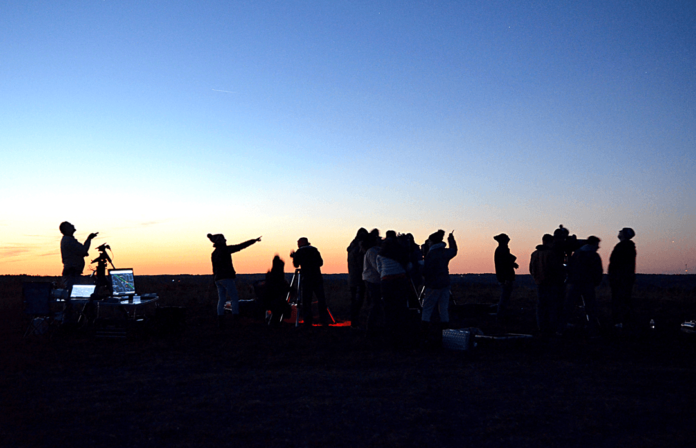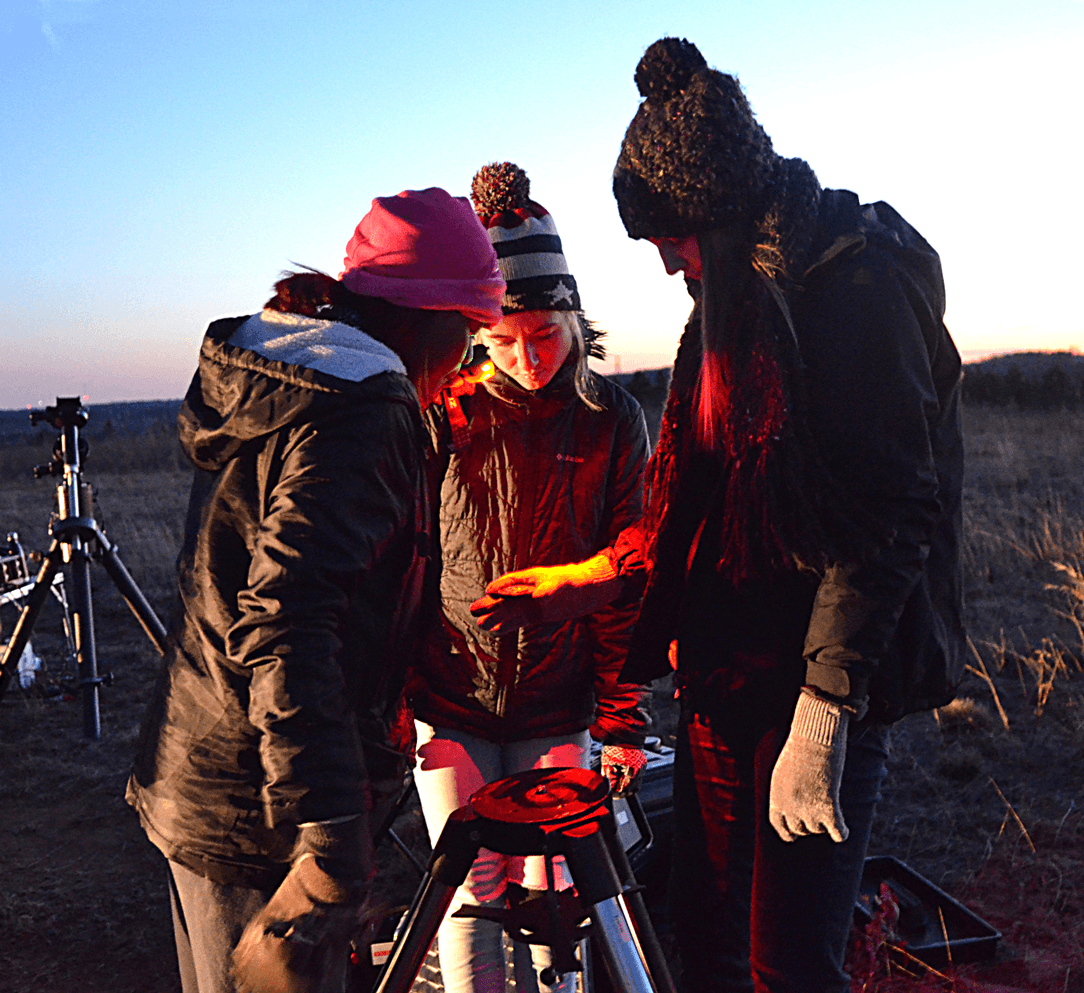
Bundled up in coats, scarves, gloves and boots, two dozen Mercer students braved the January chill for a lesson under the stars. They gazed at planets, stars and constellations by the naked eye before peering through five telescopes set up for closer inspection of the celestial objects.
Weather-permitting, the astronomy class (Physics 115) meets at University-owned land off Causey Road in Crawford County, about 20 miles from the Macon campus, for lab on Thursday nights. Physics professor Dr. Matt Marone contends it’s Mercer’s most-beautiful classroom.
He decided to put his own spin on Physics 115 when he started teaching it in 2007. Typical astronomy classes don’t have an intensive lab, just the lecture portion and maybe a few sessions looking through a telescope. Dr. Marone said he wanted to offer a more advanced course with a strong hands-on component, so students were practicing science rather than just being bystanders.
Students study the astronomy concepts during three, 50-minute lectures each week and apply them to the real world during a weekly three-hour lab. They learn current astronomy theories, terminology and basic physics principals; how to perform simple calculations; and proper set up and use of the telescopes. They are responsible for transporting their team’s equipment to the observation site and assembling it.
Physics 115 is a general-education class open to students of all years and majors. It always fills up and has a waiting list, Dr. Marone said. It’s the only science course that some students will take while at Mercer.
“I feel kind of special being the one science person that they’re going to interact with at Mercer,” Dr. Marone said. “The thing that I like to instill in them is an idea that they can do science, they can understand science, and it’s not something that they should be afraid of.”
Senior Madeline Cole, an English major, signed up for astronomy for the current spring semester because she needed a lab science to graduate. Now, astronomy is her favorite class.

Junior Ariel Dornisch, an environmental engineering major, was excited to discover that Physics 115 would count as one of her science lab requirements. She said she has been interested and fascinated by astronomy for as long as she can remember.
The labs for the course start around sunset, to give the eyes time to adjust to the darkening night sky. To preserve their night vision, students are only allowed to use red light flashlights once it’s dark.
Dr. Marone sets up a generator, computer and monitor at the site so he can show his students various nighttime objects on a computer program called Starry Night. He also points things out in the sky with a green laser pointer. Then, the students locate stars and constellations on their telescopes.
Everyone establishes their own identifiers and ways for memorizing the stars and constellations, Cole said. For example, she knows that once she finds Betelgeuse in Orion’s Belt, she’ll be able to pinpoint other constellations in relation to it.
On Jan. 31, class members found the stars Polaris, Mirach, Cassiopeia and Sirius; planets Mars and Uranus; and deep sky objects M1, M35, M37 and M103. They recorded notes, observations and sketches for their lab reports, including a shooting star sighting at 7:30 p.m. Dr. Marone connected a DSLR camera to a telescope to take vibrant, long-exposure photos of the Orion Nebula.
“In so many of my other classes, I’m being taught things that I’ve definitely had precursors to,” Dornisch said. “But in this one, everything that we’re learning is pretty much new to me. It’s not anything I’ve learned before, which makes it equally exciting and difficult.”
Plans are in the works to build an observatory on this Crawford County land in the future. While a timeline hasn’t been established for the project, preliminary designs have been created and a large telescope has been acquired to go inside the observatory, Dr. Marone said.

Indoor labs are held on campus when the weather doesn’t cooperate. On Feb. 14, students started using the Starry Night software to create planetarium shows for elementary students, and they worked on those projects during a few other cloudy/rainy lab nights.
Dr. Marone encourages his astronomy students to apply their unique interests and strengths to their assignments. For example, he urged Cole, a musician, to create original music for her planetarium show, she said. She used a synthesizer to speed up music she composed on the keyboard, and it plays in the background of her video.
“It makes me more passionate about the project and more emotionally invested,” Cole said. “That’s what makes this class memorable, not just exciting. I feel like I’ll always carry the memories of this class in my future.”
Dornisch said she loves the passion that Dr. Marone shows for the subject matter, as well as the personal stories and artifacts he adds to the lessons. For instance, he brought in a piece of the moon one day for the class members to see and touch.
Students get an appreciation for the sky and nature, and they walk away with skills they can use for years to come, Dr. Marone said. Decades from now, they will be able to look up to the sky and point out objects.
“It’s something I’ve never been able to experience before, actually being able to look through the telescope and know what things are,” Dornisch said. “Taking the course has made me realize how small Earth is and how there’s this whole bigger picture happening elsewhere. We’re just one little planet.”
It can be an eye-opening experience for some students as they realize how vast the universe is, Dr. Marone said. Many are awed by the up-close and personal views of things they’ve only ever seen in pictures before, such as the rings of Saturn or craters on the moon.
“I’m doing something that I never thought I’d be able to do,” Cole said. “I know (this knowledge) is something I’ll carry with me for the rest of my life. It’s something that I want to give my kids one day. It’s something that I’m already showing my sister. It’s very special. I want to keep it forever.”
Have a suggestion for a unique Mercer course to be highlighted in our new Classroom Spotlight series? Email your idea to honaker_am@mercer.edu









